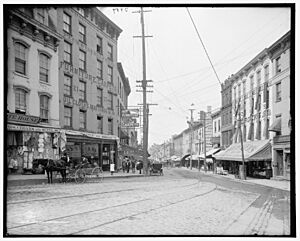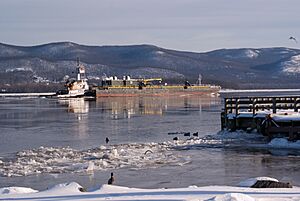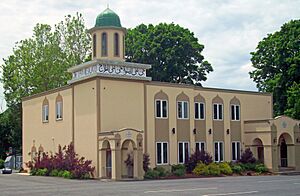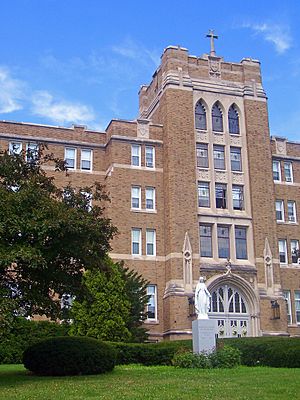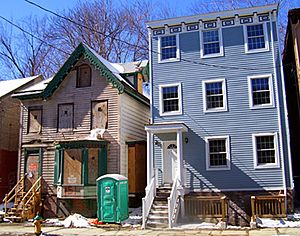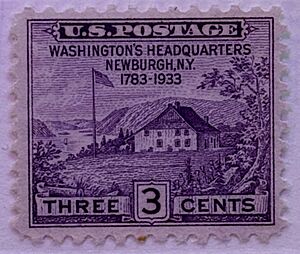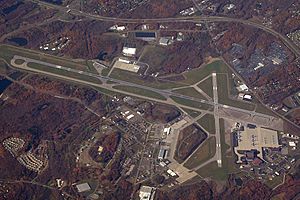Newburgh, New York facts for kids
Quick facts for kids
Newburgh, New York
|
|||
|---|---|---|---|
Downtown Newburgh from Beacon,
across the Hudson River |
|||
|
|||
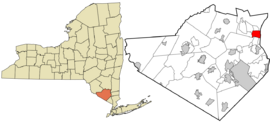
Location in Orange County and the state of New York.
|
|||
| Country | United States | ||
| State | New York | ||
| County | Orange | ||
| Settled | 1709 | ||
| Village Incorporation | March 25, 1800 | ||
| City incorporation | 1865 | ||
| Government | |||
| • Type | Council–manager | ||
| Area | |||
| • City | 4.78 sq mi (12.39 km2) | ||
| • Land | 3.81 sq mi (9.86 km2) | ||
| • Water | 0.98 sq mi (2.53 km2) | ||
| Highest elevation | 690 ft (210 m) | ||
| Lowest elevation | 0 ft (0 m) | ||
| Population
(2020)
|
|||
| • City | 28,856 | ||
| • Density | 7,581.71/sq mi (2,927.24/km2) | ||
| • Metro | 670,301 | ||
| Demonym(s) | Newburgher | ||
| Time zone | UTC-5 (Eastern) | ||
| • Summer (DST) | UTC-4 (Eastern) | ||
| ZIP Code |
12550
|
||
| Area code(s) | 845 | ||
| FIPS code | 36-071-50034 | ||
| GNIS feature ID | 0958498 | ||
| FIPS code | 36-50034 | ||
| Primary airport | Stewart International Airport | ||
Newburgh is a city in Orange County, New York. It is located about 60 miles (97 km) north of New York City. The city sits on the Hudson River in the Hudson Valley area. In 2020, its population was 28,856 people. Newburgh is also close to Stewart International Airport.
The Newburgh area was first settled in the early 1700s. People from Germany and Britain moved there. During the American Revolution, Newburgh was the main base for the Continental Army. The city of Newburgh became official in 1865. Before that, it was part of the town of Newburgh. The town still borders the city to the north and west.
Across the Hudson River to the east is the city of Beacon, New York. The Newburgh–Beacon Bridge connects the two cities. The southern border of Newburgh is with the town of New Windsor, New York. This border mostly follows Quassaick Creek. In 2016, Newburgh asked for help with its water supply. This was due to water quality issues.
Newburgh has many important landmarks. These include Washington's Headquarters and the Dutch Reformed Church. Famous people like George Washington and Franklin D. Roosevelt had connections to the city. Newburgh was also important for a style of building called Gothic Revival architecture. This style was led by local designer Andrew Jackson Downing.
Mount Saint Mary College is a private college located in Newburgh.
Contents
Exploring Newburgh's Past
Early Settlements and Important Events
When Europeans first arrived, the Esopus people, a branch of the Lenape, lived in the Newburgh area. In 1609, Henry Hudson explored the river that now carries his name. His navigator, Robert Juet, may have called the site "a pleasant place to build a town."
Around 1683, Governor Thomas Dongan bought the land from the Waoranek people. The first European settlers arrived in 1709. They were 54 refugees from Palatine, Germany. Queen Anne of Great Britain supported them. They named their settlement the Palatine Parish by Quassic. In 1743, a ferry started running between Newburgh and Fishkill Landing (now Beacon). In 1752, the area was named "Newburgh." This name might have come from a town in Scotland.
Newburgh During the American Revolution
From April 1782 to August 1783, General George Washington used the Hasbrouck family farmhouse as his headquarters. This was the longest time Washington stayed at any of his headquarters. In March 1782, Washington received a letter from Lewis Nicola. Nicola suggested Washington become king of the United States. Washington strongly refused this idea. To honor his refusal, Kings Highway was renamed Liberty Street.
In March 1783, some army officers were upset about not being paid by Congress. An anonymous letter asked them to meet and demand payment. This event is known as the "Newburgh Conspiracy." Washington spoke to his officers in what is called the "Newburgh Address." He convinced them to stay loyal to Congress and to him. A month later, Washington announced the end of fighting with Great Britain. This marked the end of the American Revolution. The Hasbrouck House was bought by New York State in 1850. It became the first publicly owned historic site in the United States.
How Newburgh Grew Over Time
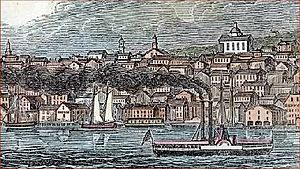
Newburgh's first newspaper, The Newburgh Packet, started in 1793. Newburgh became a village in 1800. It was originally in Ulster County, New York. When Rockland County was formed, Newburgh became part of Orange County. This meant Newburgh was no longer the county seat.
By 1793, four sloop lines operated from Newburgh. New roads called turnpikes helped trade grow. Farmers' wagons would block streets waiting to unload at the docks. The opening of the Erie Canal changed trade routes. However, prosperity returned when railroads arrived. The Newburgh Branch railroad opened in 1850.
Newburgh officially became a city in April 1865. The city became very successful during the Gilded Age. Telephone service arrived in 1879. By 1883, steamboats and trains connected Newburgh to other major cities.
Newburgh's location on the Hudson River made it a transportation and industrial center. Many factories operated here. They made things like cotton, wool, paper, hats, and tools. There were also shipyards and foundries. Newburgh was home to the second Edison power plant. It was also the second American city to have a street lit by electricity. Broadway, one of New York State's widest streets, runs through the city.
Newburgh in the 1900s and 2000s
Newburgh played a role in television history. In 1939, RCA chose Newburgh to test new televisions. Six hundred sets were sold at a low price. This success helped RCA develop television for everyone.
Newburgh was one of the first cities to add fluoride to its water in 1945.
In the late 1900s, many factories in Newburgh closed. They moved to places with cheaper labor. The Hudson River lost its importance for shipping goods. Cars became more popular, and people moved to the suburbs. In 1963, the Newburgh–Beacon Bridge opened. This bridge allowed traffic to bypass the city. The ferry service closed, and the waterfront area declined.
New shopping centers opened outside the city. They drew businesses away from downtown Newburgh. The city's downtown area lost many stores.
In the late 1960s, the city tried to fix its economic problems. They started an urban renewal plan. Many historic buildings along the waterfront were torn down. New housing projects were planned, but not all were built. Today, these areas are open, grassy slopes with river views.
In the early 1960s, city manager Joseph McDowell Mitchell tried to change welfare rules. He wanted welfare recipients to pick up payments at the police station. This caused a national debate.
Today, Newburgh is a diverse city. It has a growing Latin American population, especially from Mexico. There is also a large African American community.
Newburgh's Location and Environment
Newburgh is in the Hudson Valley region of Downstate New York. It is on the west bank of the Hudson River. The town of Newburgh borders the city to the north and west. The town of New Windsor is to the south.
The land in Newburgh rises sharply from the river. Many historic buildings are on this bluff. They offer great views of the Hudson Highlands. To the east, you can see Beacon Mountain. The Newburgh–Beacon Bridge is to the north. The lowest point in the city is at sea level by the river. The highest point is about 690 feet (210 m) on Snake Hill.
Newburgh covers about 4.78 square miles (12.4 km2). About 3.81 square miles (9.86 km2) is land, and 0.98 square miles (2.53 km2) is water. Newburgh is part of the larger New York metropolitan area.
Weather in Newburgh
Newburgh has a climate that is a mix of humid subtropical and humid continental. This means it has warm, humid summers and cold, damp winters.
On average, Newburgh gets 191 sunny days each year. Winters can bring about 36.8 inches (934.72 mm) of snow. January and February are the coldest months. The average low temperature is 18 degrees Fahrenheit (-7.7 Celsius). Summers are hot and humid. July has an average high of 85 °F (29.4 °C). Newburgh receives about 47 inches (1,193.8 mm) of rain annually.
| Climate data for Newburgh, New York (Stewart International Airport) | |||||||||||||
|---|---|---|---|---|---|---|---|---|---|---|---|---|---|
| Month | Jan | Feb | Mar | Apr | May | Jun | Jul | Aug | Sep | Oct | Nov | Dec | Year |
| Record high °F (°C) | 71 (22) |
75 (24) |
87 (31) |
96 (36) |
97 (36) |
102 (39) |
103 (39) |
103 (39) |
105 (41) |
91 (33) |
82 (28) |
75 (24) |
105 (41) |
| Mean daily maximum °F (°C) | 35 (2) |
39 (4) |
48 (9) |
61 (16) |
71 (22) |
80 (27) |
85 (29) |
83 (28) |
75 (24) |
63 (17) |
51 (11) |
40 (4) |
61 (16) |
| Mean daily minimum °F (°C) | 18 (−8) |
20 (−7) |
28 (−2) |
38 (3) |
48 (9) |
57 (14) |
61 (16) |
60 (16) |
53 (12) |
45 (7) |
33 (1) |
22 (−6) |
40 (5) |
| Record low °F (°C) | −22 (−30) |
−18 (−28) |
−3 (−19) |
15 (−9) |
27 (−3) |
38 (3) |
45 (7) |
40 (4) |
29 (−2) |
19 (−7) |
8 (−13) |
−13 (−25) |
−22 (−30) |
| Average precipitation inches (mm) | 3.66 (93) |
3.20 (81) |
3.89 (99) |
4.13 (105) |
4.11 (104) |
4.56 (116) |
4.59 (117) |
4.61 (117) |
4.47 (114) |
4.99 (127) |
4.33 (110) |
4.20 (107) |
50.74 (1,289) |
| Source: The Weather Channel | |||||||||||||
Who Lives in Newburgh?
| Historical population | |||
|---|---|---|---|
| Census | Pop. | %± | |
| 1860 | 12,578 | — | |
| 1870 | 17,014 | 35.3% | |
| 1880 | 18,049 | 6.1% | |
| 1890 | 23,087 | 27.9% | |
| 1900 | 24,943 | 8.0% | |
| 1910 | 27,805 | 11.5% | |
| 1920 | 30,366 | 9.2% | |
| 1930 | 31,275 | 3.0% | |
| 1940 | 31,883 | 1.9% | |
| 1950 | 31,956 | 0.2% | |
| 1960 | 30,979 | −3.1% | |
| 1970 | 26,219 | −15.4% | |
| 1980 | 23,438 | −10.6% | |
| 1990 | 26,454 | 12.9% | |
| 2000 | 28,259 | 6.8% | |
| 2010 | 28,866 | 2.1% | |
| 2020 | 28,856 | 0.0% | |
| U.S. Decennial Census | |||
In 2018, Newburgh's population was estimated to be 28,282. The city is very diverse. About 20.1% of residents were non-Hispanic white. About 24.2% were African American. Over half, 50.8%, were Hispanic or Latino. This group includes many people of Mexican and Puerto Rican descent.
About 31.7% of the population was under 18 years old. The average age in Newburgh was 29.1 years. Most people (55.4%) spoke only English. However, 44.6% spoke another language. Many people (41.5%) understood Spanish.
The average household income from 2014 to 2018 was $37,900. About 51.5% of residents lived below the poverty line.
Places of Worship
About 53.5% of people in Newburgh are religious. The largest group is the Catholic Church (35.7%). Other Christian groups include Methodists, Presbyterians, and Lutherans.
Judaism is the second largest religious group. Jews make up 6.5% of the faith community. The Jewish Federation of Orange County is in Newburgh. There are also synagogues like Congregation Agudas Israel.
About 1.1% of people follow Islam. A small number (0.2%) follow Eastern religions like Hinduism or Buddhism.
St. George's Episcopal Church
St. George's Church started in 1728. It received a special charter from King George III in 1770. The church was re-established in 1805. In 1838, Rev. Dr. John Brown started St. George's Cemetery. This cemetery was open to people of all races and beliefs. The church building was built in 1819.
St. Patrick's Roman Catholic Church
The first Catholic service in Newburgh was around 1816. St. Patrick's Church was officially founded in 1836. A stone church building was finished in 1842. Bishop John Hughes dedicated it in 1849. The church also started a library association.
In 1879, Monsignor J.F. Mooney became the pastor. He started Calvary Cemetery in 1898. St. Patrick's began offering services in Spanish in the mid-1960s. This helped serve the growing Hispanic community.
St. Mary's Roman Catholic Church
St. Mary's Church was founded in 1875. The first mass was held in an opera house. In 1880, the church building was built. Mount Saint Mary College was founded in 1883. St. Mary's Parochial School opened in 1886.
St. Mary's Parish joined with St. Patrick's in 2015. The St. Mary's church building has not been used since then.
Newburgh's Economy
Newburgh used to be a very important economic center. It was located between New York City and Albany. However, the city's economy declined from the 1960s onward. This was partly due to people moving to the suburbs.
As of 2020, over 11,400 people work in Newburgh. The biggest industries are retail, healthcare, and food services. Finance, public administration, and education also provide many jobs.
Arts and Culture in Newburgh
Protecting Newburgh's History
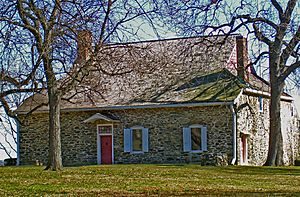
Newburgh has a long history of protecting its landmarks. In 1850, Washington's Headquarters became the first state historic site in the country. The Historical Society of Newburgh Bay and the Highlands was formed in 1884. Their home is the David Crawford House, built in 1830.
Modern efforts to save historic buildings began in the 1960s. The Dutch Reformed Church was going to be torn down. This led to the creation of a historic district. The church was added to the National Register of Historic Places in 1970. In 2001, it became a National Historic Landmark.
Newburgh was named a Preserve America community in 2005. Its East End Historic District has many historic buildings. Newburgh's old buildings were designed by famous architects. These include Alexander Jackson Davis and Calvert Vaux. Many people who care about history have invested in renovating properties in Newburgh.
Places to Visit and Learn About History
- Old Town Cemetery — This is the city's first burial ground. It has gravestones from the mid-1700s. There is a unique tomb designed in the Egyptian Revival style.
- Newburgh Colored Burial Ground — This was once a cemetery for Black people. It was destroyed around 1900. An archaeological dig found hundreds of remains there.
- St. George's Cemetery — An early planned cemetery with several important burials. It is maintained by St. George's Episcopal Church.
- Washington's Headquarters State Historic Site — This was George Washington's headquarters during the end of the Revolutionary War. It is the first publicly owned historic site in the United States.
- David Crawford House — This is the home of the Historical Society of Newburgh Bay and the Highlands. It serves as a museum and library.
- Downing Park — A public park designed by Vaux and Olmstead. It has pathways, a small pond, and a pergola.
Sports in Newburgh
Delano-Hitch used to be the home field for the Newburgh Black Diamonds and Newburgh Nighthawks baseball teams.
The Hudson Valley Renegades are a minor league baseball team. They are connected to the New York Yankees. They play at Dutchess Stadium in nearby Fishkill.
Education in Newburgh
In 1978, students at Newburgh Free Academy protested. This led to big changes in the school system. The city is served by the Newburgh Enlarged City School District.
The local high school is Newburgh Free Academy. It is the largest public high school in Orange County. It has about 3,000 students in grades 9–12. The academy has three campuses: NFA Main, NFA North, and NFA West.
Two colleges are located in Newburgh: Mount Saint Mary College and the Newburgh campus of SUNY Orange.
Media in Newburgh
Newburgh is part of the New York City media market. It has several local newspapers. These include The Mid Hudson Times and The Times Herald-Record. Major newspapers like The New York Times are also available. For television, residents can watch News 12 Hudson Valley.
Getting Around Newburgh
Transportation Options
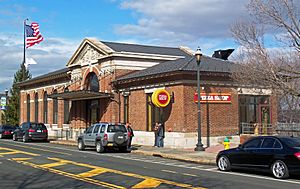
Allegiant Air, Breeze, and Play airlines offer flights from Stewart International Airport. This airport is west of the city.
You can take the Metro-North Railroad from Beacon station. This station is across the Hudson River. You can get there by using the Newburgh–Beacon Ferry during busy hours. The train connects to New York City's Grand Central Terminal. There is also train service from Salisbury Mills–Cornwall station to Hoboken Terminal in New Jersey.
The River Rose is a sightseeing ferry. It offers local cruises on a paddlewheel boat from May to October. Hudson River Adventures also runs sightseeing tours on its Pride of the Hudson boat.
Bus services are available in Newburgh. Ulster County Area Transit offers limited service to New Paltz. Short Line buses connect Newburgh to New Jersey and New York City. Newburgh Area Transit provides local bus service. Leprechaun Lines connects Newburgh, Beacon, and Stewart Airport.
Major roads like New York State Route 32 and U.S. Route 9W pass through Newburgh. Interstate 84 is just north of the city. The New York State Thruway (I-87) is not far to the west.
Hospitals and Healthcare
Newburgh has several hospitals and medical centers. These include Montefiore St. Lukes Cornwall Hospital. The Veterans Health Administration (VA) also has a facility here.
Water Supply
In May 2016, Newburgh asked for help with its water supply. This was due to water quality issues. The city has been working to address these concerns.
Famous People from Newburgh
- Shad Barry, former MLB player
- William W. Belknap (1829–1890), U.S. Secretary of War
- Harry Griffith Cramer Jr. (1926-1957) US Army Special Forces captain
- Andrew Jackson Downing (1815–1852), architect and landscape designer
- Geraldine Ferraro (1935–2011), U.S. House of Representatives member and vice presidential candidate
- Pardison Fontaine (1989-), singer, songwriter and rapper
- Michael C. Gross (1945–2015), artist and film producer (designed Ghostbusters logo)
- William S. Hart (1864–1946), actor
- Ellsworth Kelly (1923–2015), artist
- Judy Kennedy, (1945–2018), former Mayor of Newburgh
- Jeff Klein (1976–), singer, songwriter and musician
- Lee Lorenz, cartoonist
- Rob Affuso, former drummer of the band Skid Row
- Albert J. Myer (1828–1880), United States Army general
- Benjamin Barker Odell, Jr. (1854–1926), former U.S. Congressman and Governor of New York State
- James Patterson (1947–), novelist
- Homer Ramsdell (1810—1894), influential businessman
- Joe Steffy, football player and Korean War veteran
- Paul Teutul Sr. (1949–), founder of Orange County Choppers
- James Varick (1750—1827) first bishop of the African Methodist Episcopal Zion Church
- Saul Williams (1972–), poet, actor and hip hop artist
- John E. Wool (1784–1869), officer in the U.S. Army
See also
 In Spanish: Newburgh (Nueva York) para niños
In Spanish: Newburgh (Nueva York) para niños






